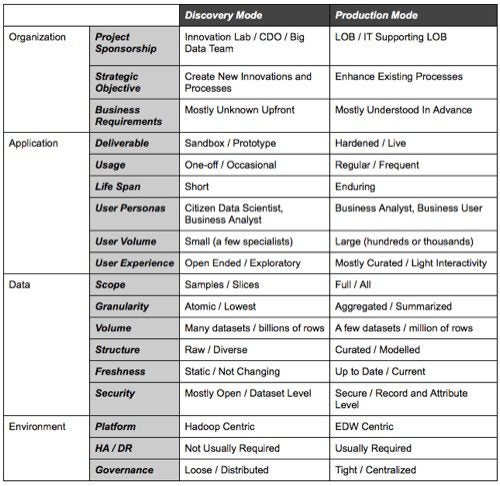When users talk about the features they require of their BI tools when working with big data, they typically end up describing their requirements in terms of two overarching themes relating to high-level analytical techniques, or modes of analysis. These can be summarized as follows: Discovery Mode: Explore and Experiment – Ask new business questions […]
Datamation content and product recommendations are
editorially independent. We may make money when you click on links
to our partners.
Learn More
When users talk about the features they require of their BI tools when working with big data, they typically end up describing their requirements in terms of two overarching themes relating to high-level analytical techniques, or modes of analysis. These can be summarized as follows:
Discovery Mode: Explore and Experiment – Ask new business questions on unknown data.
Production Mode. Monitor and Adjust – Provide trusted answers from data that is understood.
This article discusses these two modes of analysis, the differences between them and how they ultimately work together for better decision making and new business innovation. These guidelines can also be used when evaluating new and existing BI tools for your big data environment.
Before we look in detail at how these modes of analysis differ, we should note that they are highly complementary and always work together. Typically, new insights resulting from efforts in discovery mode become operationalized in production mode. For example, in discovery mode an online retailer develops a new way to segment and score potential customers based on their social media preferences. In production mode, purchasing behavior within the new customer segments is monitored to understand effectiveness so the segmentation strategy can be adjusted accordingly.
Conversely, what we learn in production mode generates new questions requiring new data that first needs prototyping in discovery mode before operationalizing. In our example above, we decide our segments need enhancing with some TV viewing data that recently became available. In this case we need to re-enter discovery mode to decide how to best incorporate this data into our segmentation model.
Given the definition of these modes of analysis are and how they work together it is worth taking a look at the differences between them as this drives the need for different sets of product capabilities required of our BI tools.
To help us explain the differences we will look at the modes of analysis across 4 distinct angles. These are:
* The organizational factors driving the need for analytics
* The types of applications and features being developed
* The requirements for the data
* The desired technology environment
Below is how modes of analysis differ across these categories:

A BI tool should provide product capabilities to enable both of these modes of analysis. It is important that modern BI tools appreciate the full breadth of the analytics lifecycle and this often begins in discovery mode then heads into production mode later on (and iteratively back into
discovery mode as time passes – as discussed above), especially when organizations are aim to deliver brand new innovation through analytics on big data. These types of projects often start with little or no understanding of requirements upfront and no prior knowledge of the data sources and structures to be incorporated.
Organizations should not have to switch BI tools to move between discovery and production modes. There should be no artificial tradeoffs imposed between data and user volume for example, modern BI tools should have the fundamental capabilities in place to handle both type of analytic scenarios.
Will your existing BI tool stand up to these tests?
About the author: Richard Tomlinson is the Senior Director of Product Management at Arcadia Data
-
Huawei’s AI Update: Things Are Moving Faster Than We Think
FEATURE | By Rob Enderle,
December 04, 2020
-
Keeping Machine Learning Algorithms Honest in the ‘Ethics-First’ Era
ARTIFICIAL INTELLIGENCE | By Guest Author,
November 18, 2020
-
Key Trends in Chatbots and RPA
FEATURE | By Guest Author,
November 10, 2020
-
Top 10 AIOps Companies
FEATURE | By Samuel Greengard,
November 05, 2020
-
What is Text Analysis?
ARTIFICIAL INTELLIGENCE | By Guest Author,
November 02, 2020
-
How Intel’s Work With Autonomous Cars Could Redefine General Purpose AI
ARTIFICIAL INTELLIGENCE | By Rob Enderle,
October 29, 2020
-
Dell Technologies World: Weaving Together Human And Machine Interaction For AI And Robotics
ARTIFICIAL INTELLIGENCE | By Rob Enderle,
October 23, 2020
-
The Super Moderator, or How IBM Project Debater Could Save Social Media
FEATURE | By Rob Enderle,
October 16, 2020
-
Top 10 Chatbot Platforms
FEATURE | By Cynthia Harvey,
October 07, 2020
-
Finding a Career Path in AI
ARTIFICIAL INTELLIGENCE | By Guest Author,
October 05, 2020
-
CIOs Discuss the Promise of AI and Data Science
FEATURE | By Guest Author,
September 25, 2020
-
Microsoft Is Building An AI Product That Could Predict The Future
FEATURE | By Rob Enderle,
September 25, 2020
-
Top 10 Machine Learning Companies 2020
FEATURE | By Cynthia Harvey,
September 22, 2020
-
NVIDIA and ARM: Massively Changing The AI Landscape
ARTIFICIAL INTELLIGENCE | By Rob Enderle,
September 18, 2020
-
Continuous Intelligence: Expert Discussion [Video and Podcast]
ARTIFICIAL INTELLIGENCE | By James Maguire,
September 14, 2020
-
Artificial Intelligence: Governance and Ethics [Video]
ARTIFICIAL INTELLIGENCE | By James Maguire,
September 13, 2020
-
IBM Watson At The US Open: Showcasing The Power Of A Mature Enterprise-Class AI
FEATURE | By Rob Enderle,
September 11, 2020
-
Artificial Intelligence: Perception vs. Reality
FEATURE | By James Maguire,
September 09, 2020
-
Anticipating The Coming Wave Of AI Enhanced PCs
FEATURE | By Rob Enderle,
September 05, 2020
-
The Critical Nature Of IBM’s NLP (Natural Language Processing) Effort
ARTIFICIAL INTELLIGENCE | By Rob Enderle,
August 14, 2020
SEE ALL
APPLICATIONS ARTICLES








